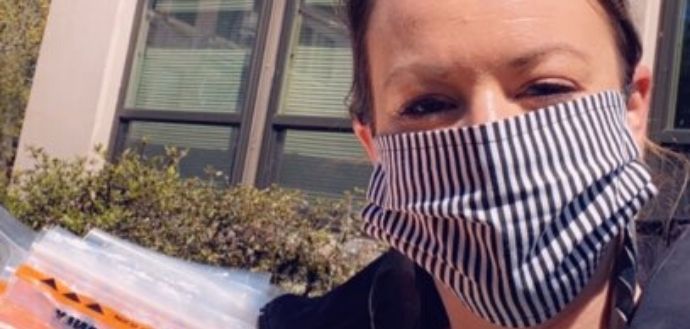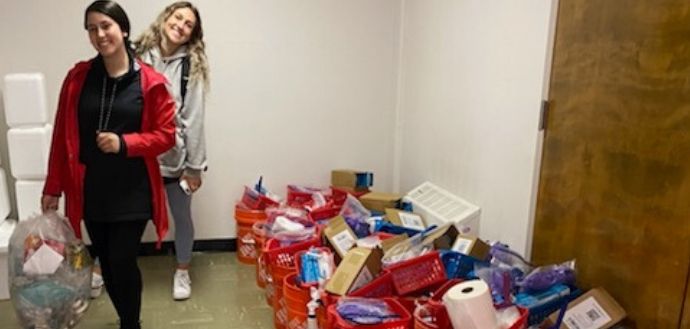
CPHHS alumna Aslan Noakes, RN, MPH, is no stranger to making plans on the fly. This mother, nurse, multitasker, entrepreneur, organizer and master of triage is field manager for OSU’s TRACE-COVID-19 study. Or, as her team calls her, “chaos coordinator.”
Hardly chaos with Aslan’s organizational skills, the operations of the weekend field team are streamlined, and most importantly, safe. She ensures that all equipment and supplies are in order so that the 60-member team can collect good samples from community members.
“If we don’t have good samples, we don’t have good data, and if we don’t have good data, we don’t have a good study,” she says.
She also makes sure field teams are prepared each weekend, runs a WhatsApp group so teams can communicate their needs, supports the team physically and emotionally, and ensures that team members get tested weekly to maintain their safety and that of the community.
The sampling teams consist of paid traditional health workers, as well as OSU students, many of whom are studying public health and who are being paid. They visit 30 neighborhoods each weekend, collecting samples from Corvallis residents so that the TRACE research team can help determine the prevalence of COVID-19 in the city.
Other OSU students are supporting the effort by volunteering to do data entry or working at a call center to answer questions from the community.
Plan B? No problem.
In addition to serving as field manager, Aslan runs a for-profit social business to promote sustainable and empowering partnerships in Haiti and works at OSU’s Student Health Services. Because of COVID-19, she found herself grounded and looking for work due to being furloughed.
Cue, TRACE.
Her second day of work coincided with the field team’s pilot into Corvallis neighborhoods. Aslan was ready. “Everything I’ve done in Haiti has almost been my gym, preparing me for this moment. In Haiti, there are always challenges. I’m used to having Plan B in my pocket. I’m ready for things to not work, so I can handle the stress. My feathers don’t ruffle easily.”

Aslan is grateful for the opportunity to be part of a project that includes professors she admired as a student – and one that makes a difference.
“Public health is incredibly relevant for the well-being of our community, and playing an active role in that is incredible,” she says. “I feel this job was created for me and meets all my strengths. I’ve never worked so hard and loved a job so much at the same time.
“It’s the first opportunity I’ve had to use my MPH and RN together, stateside, and I’m soaking it up. It’s so exciting to be part of something bigger than myself. It’s exhilarating, really. And to be able to work in my own community and for my alma mater feels really good. I’m loving every minute.”
Hands-on learning and a meaningful contribution
Because she was once an OSU student herself, Aslan takes her responsibility to current students to heart.
“They are so excited to be able to do something for their community. Staying home is doing a huge thing, but being able to participate actively during the outbreak feels very relevant and makes them feel valued,” she says. “They’re seeing what public health looks like firsthand as we respond to a pandemic, and what it looks like behind the scenes. They see and hear the things I’m juggling to make fieldwork happen, and I think it all makes for a great experience.”
At her side is intern Laura De la Torre, who helps manage the team on field days and with field staff testing days. “Working with Aslan is amazing,” she says. “She has taught me what I could have never learned in books. She is the best at coming up with solutions to unexpected problems in a calm, yet efficient matter. She’s a busy woman, so there’s always a lot to do, which is good because we never get bored! I notice that she always cares about the well-being of those around her and I admire that of her.”

First-year MPH student and TRACE field technician Joe Harrity agrees. “Aslan’s organizational skills are incredible. She has an extremely well-developed ability to produce solutions for countless little interlocking problems while maintaining awareness of the bigger picture. She is a clear and fast communicator, she has an uncanny memory for all aspects of the project, and she seems to do a superhuman amount of work. Her attitude and disposition are a huge benefit to the project as well. In spite of constantly responding to a volume of questions and problems that would make my head spin, she is almost always upbeat and displays a reassuring sense of confidence and humor.”
Joe, who hands out materials and manages those materials and samples, also handles logistics for how the team navigates neighborhoods. He says he wanted to be part of the project for several reasons.
“First, I thought working on the project would give me invaluable exposure to the process of epidemiological research. Second, as a young, healthy person I had hoped I could find a way to serve the community during the pandemic, and TRACE gave me a great opportunity. Third, I thought that my prior experiences might make me a useful member of the TRACE field team.”
Joe previously assisted in the humanitarian response to Hurricane Sandy and sees similarities to TRACE.
“The TRACE work feels similar to my experience with Hurricane Sandy in a few ways,” he says. “The seriousness and urgency of the work feels similar. In both situations it felt as though the efficiency and quality of work from my team and the project overall could have a real influence on the course of the crisis for people and communities. I think this impression makes TRACE workers take their duties very seriously. You can see TRACE team discipline in, for example, the meticulous way that traditional health workers follow infection control protocols, and the diligence of student workers in adhering to the study sampling methods.
“The pace of the work and constant need for creative problem solving also reminds me of the Sandy response. The PIs, supported by many OSU employees, designed this project with impressive speed and care. Still, in a growing project with thousands of moving parts, there are moments when fast improvisation is necessary. Little modifications, such as the orientation of a barcode on a specimen tube or the availability of replacement paperwork in an accessible location, have made a big difference in project efficiency. The constant growth of the project means that innovation and communication are critical for all team members to harmonize their efforts and conduct the project safely and effectively.
“In both the Sandy response and TRACE, I have encountered a broad range of responses to the program from the public. The most common reactions are gratitude and encouragement, which is great for field team morale. But both Sandy and the COVID pandemic caused people to feel unsettled and uncertain, and we anticipate that not everyone will feel so positively. And that’s fine; we want to make it clear to the community that participation in TRACE is voluntary and we absolutely respect the rights of community members to privacy and choice.”